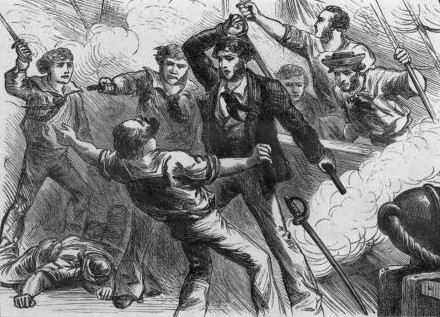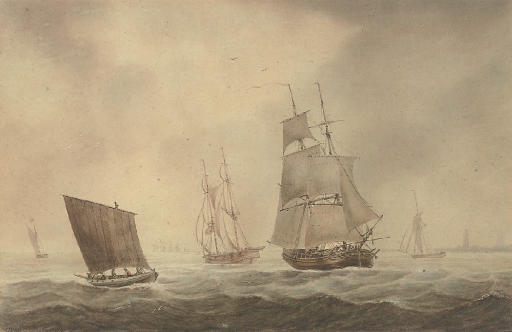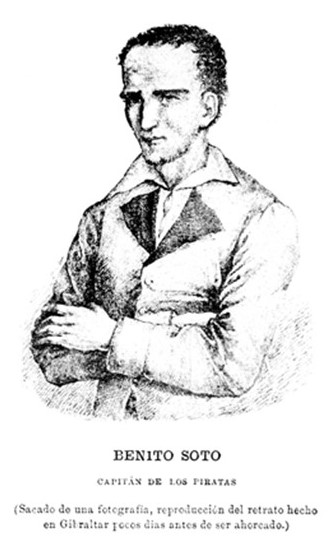Benito de Soto
Pirate of the Post-Napoleonic Era – Part 2
At the end of Part 1 of this two-part article, we left the ghastly Benito de Soto and his crew of cut-throats in possession of the British-registered Morning Star, captured off Ascension Island while en route from Ceylon to Britain. (Click here to read Part 1 if you missed it).
De Soto’s orders to “his right hand in villainy”, a certain Barbazan, were to spare no lives and to sink the ship after looting it. “The terror of the poor females and most of the rest on the Morning Star may well be imagined; nor could the fears of the former be allayed by the vain hopes which some expressed that the pirates would simply plunder the vessel and then leave them. Vain hopes indeed, for the pirates commenced cutting right and left immediately they boarded”.

The brutal reality of close-combat during boarding
The thugs were soon masters of the decks. “Beaten, bleeding, terrified, the men (passengers and crew) lay huddled together in the hold, while the pirates proceeded in their work of pillage and brutality. Every trunk was hauled forth; every portable article of value heaped for the plunder: money, plate, charts, nautical instruments, and seven parcels of valuable jewels, which formed part of the cargo; these were carried from below on the backs of those men whom the pirates selected to assist them, and for two hours they were thus employed, during which time De Soto stood on his own deck (of the “Defensor de Pedro”) watching the operations, for the vessels were within a hundred yards of each other.” The passengers were stripped of their clothes and the women were locked up together in the round-house on deck. The contemporary chronicler referred to “a series of outrages” against the women – the mind recoils from what this may have signified.

The Morning Star’s female passengers at the mercy of de Soto’s crew. Contemporary illustration
Barbazan’s orders had been to put all to death, as well as sink the ship. The last survivors were not however butchered – the women remained locked in the cabin and lumber was heaped on the hatches to trap the men sheltering in the hold. Holes were then bored in the hull beneath the waterline, so providing for slow drowning of the prisoners. After damaging masts and rigging, Barbazon and his thugs then returned to Benito de Soto on the Defensor de Pedro and left the sinking Morning Star to its fate. This course of action was however to save the ship, for the women managed to force their way out of the cabin and release the men in the hold. By now Benito de Soto’s ship was far off, with all sails set. There was however six feet of water in the Morning Star’s hold but ceaseless pumping managed to keep her afloat. It proved impossible to get her underway due to damage to the sailing gear. A passing vessel did encounter the derelict the following day and those on board were taken safely to Britain.
It was only on this same morning that Benito de Soto learned from Barbazon that survivors had been left alive when the Morning Star was abandoned. Keen to dispose of any possible witnesses, he returned to seek her but found no trace. Perhaps satisfied with the booty gained, he now set sail for Europe and on the way “met a brig, boarded, plundered, and sank her, having first murdered the crew, with the exception of one individual, whom he took with him as a pilot, as he professed to know the course to Corunna.” Within sight of this Spanish port, De Soto shot the conscripted pilot dead and flung his body overboard.

A trading brig of the time – easy meat for a ruthless pirate like Benito de Soto
Painting by Joseph Cartwright (1789 – 1829)
At Corunna, Benito de Soto obtained papers under a false name, sold most of his ill-gotten spoils, and headed for Cadiz, where he expected to dispose of the remainder. This was his undoing – his ship was driven ashore in a storm and was all but wrecked. Nothing daunted, he continued overland to Cadiz and managed to negotiate the sale of the wreck with a broker for the 1750 Dollars. The contract was signed, but the money was not yet paid, when suspicion arose from inconsistencies in accounts of de Soto’s crew. Six were arrested by the authorities but de Soto and one of the crew fled and got to British territory (a bad move!) at Gibraltar, and six escaped to Venezuela.
De Soto secured his admission into Gibraltar by a false pass, and settled in at “a low tavern”. A British officer there was to write later “The appearance of this was in grim harmony with the worthy Benito’s life. I have occasion to pass the door frequently at night, for our barrack, the casement, is but a few yards from it. I never look out at the place without feeling an involuntary sensation of horror…” de Soto spent his money freely – “He dressed expensively, generally wore a white hat of the best English quality, silk stockings, white trousers, and blue frock coat. His whiskers were large and bushy, and his hair was black, profuse, long, and curled. He was deeply browned with the sun, and had an air and gait expressive of his bold, enterprising, and desperate mind. Indeed, when I saw him in his cell and at his trial, although his frame was attenuated almost to a skeleton, the colour of his face a pale yellow, his eyes sunken, and his hair closely shorn, he still exhibited strong traces of what he had been, still retained his erect and fearless carriage, his quick, fiery, and malevolent eye, his hurried and concise speech, and his close and pertinent style of remark.”

de Soto on trial in Gibraltar
The Morning Star outrage was to catch up with him. Arrested at last, Benito de Soto was put on trial. Items found in his room constituted strong evidence against him – a dirk that had belonged to one of his victims, a trunk and clothes taken from another, and the pocket-book containing the handwriting of the Morning Star’s ill-fated captain. Evidence was also given by his own slave boy. According to the near-contemporary account, “when Sir George Don passed the just sentence of the law upon him his face was a study of concentrated venom. The wretched man persisted up to the day of his execution in asserting his innocence; but the certainty of his doom seemed to make some impression on him, and he at last made an unreserved confession of his crimes, giving up to the keeper a razor-blade which he had secreted in his shoes for the avowed purpose of committing suicide.”
He may have felt genuine remorse. “On the day of his execution (in January 1830) he walked firmly at the tail of the fatal cart, gazing alternately at the crucifix he held in his hand and at his coffin, and repeated the prayers spoken in his ears by the attendant clergyman with apparent devotion.” He was to be hanged by the method of the cart he was standing being driven away from the gallows and leaving him suspended. He was apparently calm and resigned. When the hangman discovered that he had set the rope at the wrong height, De Soto calmly stood on his own coffin and obligingly placed his head inside the noose. His head was subsequently stuck on a pike as a warning to others. It is quite chilling to recall that this barbarous custom was still being followed in 1830.
De Soto may well have been the last deep-sea Atlantic pirates. His career reminds us forcefully that there was nothing romantic about his profession, or that it was filled with loveable rogues.



